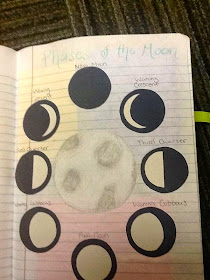
 This purpose of this blog entry is to offer some background information
This purpose of this blog entry is to offer some background information to teacher's trying to explain the Total Lunar Eclipse to their students.
What is a Total Lunar Eclipse?
A total lunar eclipse occurs when the Moon passes
directly behind the Earth into its umbra (shadow). This can occur only when the Sun, Earth, and
Moon are aligned exactly, or very closely so, with the Earth in the middle.
Hence, a lunar eclipse can only occur the night of a full moon.
Why Does the Moon Appear Red During
a Total Lunar Eclipse?
During
a total lunar eclipse, the Earth blocks the Sun's light from reaching the Moon.
The Moon is always a full moon during a total lunar eclipse and it never goes
completely dark. The Earth’s shadow has two parts: the umbra and the penumbra.
In a total lunar eclipse the moon passes directly behind the Earth’s
umbra.
The sunlight must pass
deep through the Earth's atmosphere, which filters out most of the blue colored
light. The remaining light is a deep red or orange in color and is much dimmer
than pure white sunlight. Earth's atmosphere also bends or refracts some of
this light so that a small fraction of it can reach and illuminate the Moon.
There will be a total lunar eclipse on Oct. 8, 2014, followed by another on April 4, 2015 and the last total lunar eclipse of the current tetrad on Sept. 28, 2015.
In a related topic, you could discuss phases of the moon using Oreos. I would start by giving them Oreos and having them arrange the cookies in the way they think they should go and then label them. After some input they could revise their thinking and their cookies.
Interactive Notebook Idea
Please follow this blog by clicking the follow by email button or by clicking the g+ follow button under my photograph.




